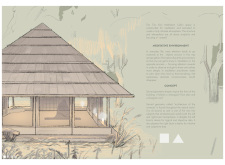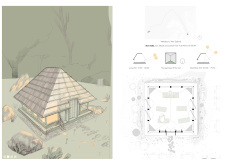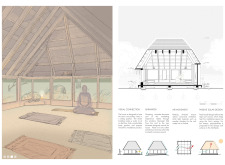5 key facts about this project
The Tiny Kiwi Meditation Cabin is a thoughtfully designed space located in a quiet area where people can escape to meditate and reflect. It focuses on simplicity and a strong connection with nature, inviting users to find tranquility and clarity. The design revolves around the principles of sacred geometry, which fosters a sense of balance and harmony that supports personal introspection.
Architecture Concept
Sacred geometry shapes the building's overall design, seen in its rectangular floor plan and triangular roof. This form not only provides visual interest but also helps create an interior space that encourages mindfulness and calmness. The cabin’s layout encourages a dialogue between the indoors and the surrounding environment, letting users engage with nature while they meditate.
Natural Ventilation and Light
This cabin features rotating windows that allow for natural ventilation. Fresh air can easily flow through the space, ensuring comfort for those inside. The high roof effectively captures sunlight, which keeps the interior bright and warm. Additionally, the roof’s angle on the north side maximizes daylight, promoting energy efficiency and reducing the need for artificial lighting and heating.
Water Management and Landscape Integration
An important aspect of the design is how it manages rainwater. Water that runs off the roof feeds into a mini bioswale located around the cabin. This feature connects those inside to the natural water cycle, offering a visual reminder of their surroundings. The plants in the bioswale soften the cabin's edges and support local plant life, reinforcing the connection to the natural landscape.
Functional Flexibility
The cabin includes a multifunctional altar for drying flowers, which adds flexibility to the space. This piece of furniture can be moved around easily, allowing users to change the layout as needed and follow the sun’s path throughout the day. This enhances the practicality of the cabin, allowing each user to tailor their environment for meditation and connection with nature.
As natural light streams in through large windows, it creates shifting patterns across the interior, contributing to an atmosphere that encourages reflection and peace.






















































